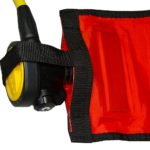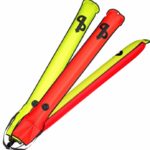A surface marker buoy (SMB) is an invaluable tool for any diver. An SMB shows boats that there are divers in the water and helps your own boat spot you as you ascend from a dive. Divers also use SMBs to note their position during a drift dive. There are many different types of surface marker buoy available, so what should you look for when buying one? Here are some of the most common features.
Types
The two main types of surface markers are the delayed surface marker buoy (DSMB) also known as the safety sausage, and the surface marker buoy (SMB). The DSMB is simply an inflatable tube that you send up to the surface from underwater as you begin your safety stop. This highlights your position in the water to boats and helps your own boat keep track of you. It can also act as a visual reference for you during your ascent.
You can inflate an SMB at the beginning of a drift dive and hold onto it during the dive so that your boat can easily follow along. This is a much more effective method for the boat driver than trying to follow your bubbles — not an easy task in even small waves.
Either type of surface marker also allows your spotter to see you far more easily if you drift a little farther from your boat. If you become lost, you can use your SMB as a signaling device to say that you need assistance by holding it horizontally above your head.
Open or closed
Open-ended DSMBs are open at the bottom. This makes them very easy to inflate and, at the end of the dive, it also allows you to deflate and store them easily. However, they tend to let in water once they reach the surface. This can make them flop into a horizontal position and create additional drag for you if you are swimming. You can reduce this effect by pulling on them to keep them upright, although it doesn’t completely stop water from getting in.


Closed DSMBs are sealed at the bottom. This means that you fill them completely with air so that they will stick upright in the water to be as visible as possible. But this also means that there’s only one method of putting air into them.
Inflation methods
On closed DSMBs, a one-way oral-inflation valve allows you to add air by blowing into it. This involves taking a breath and removing your regulator, then adding air orally into the DSMB before replacing your regulator. You may need to do this two or three times. Some models also allow you to partially insert the Low-Pressure Inflator (LPI) into the valve to add air more quickly. This is very handy for rebreather divers who don’t want to take their mouthpiece (loop) out of their mouths. It also allows you to add more air into the DSMB so that you know it will be full once it hits the surface. If you attach the DSMB to a spool, you can deploy it from deeper depths and take advantage of Boyle’s Law. As the DSMB ascends, the air inside it will expand to fill it up completely. This is standard practice for technical divers.
On open DSMBs, it’s common to use air from your exhalations to fill it from the bottom. Again, this allows the air to expand as it ascends to fill up the DSMB. Just be very careful that you don’t get any part of the DSMB or reel entangled on you or your equipment.
In warm waters, it’s common to fill your DSMB with the second-stage alternate regulator. This means you can add a lot of air quickly, but it’s not an appropriate method in cold-water environments. Especially in water close to 32 F (0 C), the risk of free-flow is very likely.
Size, shape and color
DSMBs come in numerous sizes. The largest can be 6.5 feet (2 m) or longer. Which size you choose will depend on where you go diving. If you dive in relatively calm seas with little current, then a smaller 3-foot (1 m) DSMB will suffice. But if you are likely to experience larger waves or whitecaps, then the larger the better. SMBs are often similarly shaped and sized to DSMBs, but they can also look more like a mooring buoy or a lift bag.
As for color, it’s important that your SMB contrasts highly against the color of the ocean. Standard surface markers should be red or orange. You should only use a yellow DSMB in an emergency. Reflective strips also make you easier to see on darker days and at dusk.
Attachment options
Since you deploy DSMBs from underwater, they come with different types of line. A basic nylon line around 18 feet (5.5 m) long comes with most DSMBs, which is around the same length as your safety stop is deep. This makes it easy to manage once you have deployed it, but it also means you must have it ready to deploy as soon as you reach your safety-stop depth. It is better to be able to warn boats that you’re there before you ascend to such shallow depths.
A great alternative is to attach the DSMB to a spool so that you can deploy it from 50 to 65 feet (15 to 20 m) deep. Then you have all the advantages — boats have plenty of warning; the air you put into it will expand, and you have a visual reference for your ascent.
When thinking of buying a surface marker buoy, talk to dive professional about the best one for you. They can also help you to learn safe and effective methods of deployment before you take one on a dive. No matter which kind you get, you’re safer underwater with an SMB.
The post Choosing the Right Surface Marker Buoy appeared first on Scuba Diver Life.
from Scuba Diver Life http://ift.tt/2E41S4j
No comments:
Post a Comment